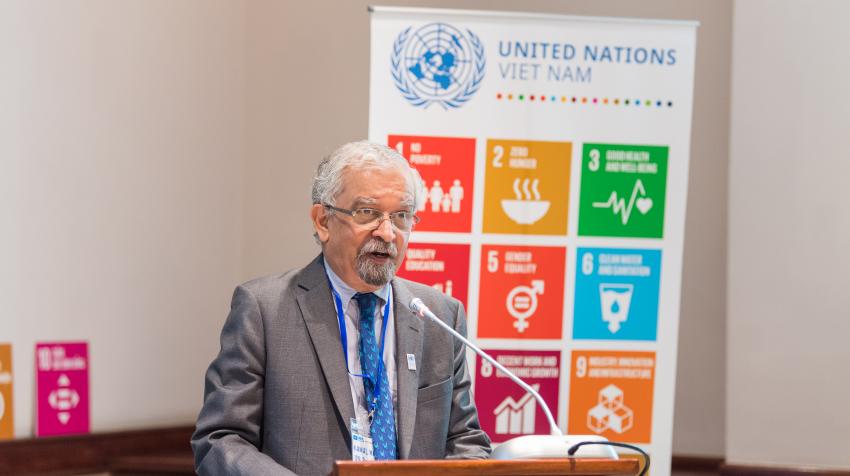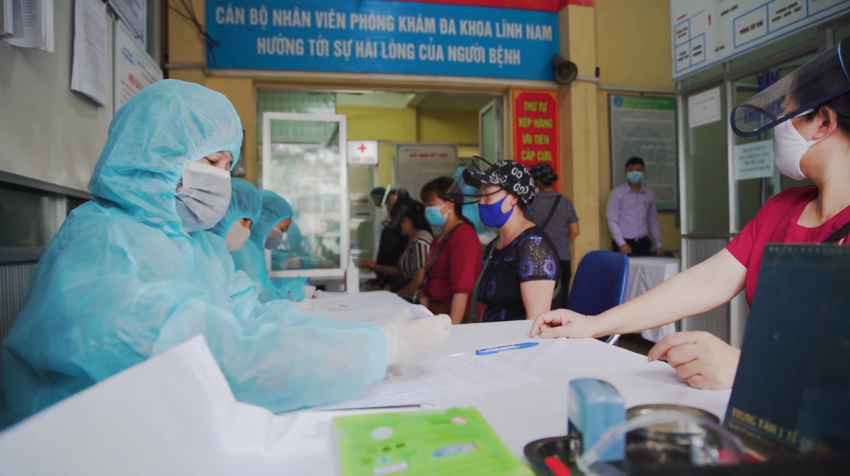It is globally recognized that Viet Nam has demonstrated one of the world’s most successful responses to the COVID-19 pandemic. Following measures implemented between 23 January and 16 April 2020, no cases of local transmission were recorded for 99 consecutive days, despite a new outbreak of infection that began on 25 July, which Viet Nam is now also in the process of bringing under effective control. Prior to 25 July, there were fewer than 400 cases of infection across the country, most of which originated outside of Viet Nam. Most of those infected recovered and none died—a remarkable accomplishment considering the country’s population size of 96 million people and its sharing of a 1,450 km land border with China.
Viet Nam’s success has drawn international attention because of its early, proactive, transparent, whole-of-political system and whole-of-society action led by the Government. With the support of the World Health Organization (WHO) and others, Viet Nam had been preparing and improving its health system, especially to prevent, prepare for, detect and respond to public health emergencies, as part of its long-term investment plan. The country was building on lessons learned from previous outbreaks, including SARS in 2003, which it also handled with remarkable success.
Viet Nam’s successful management of the COVID-19 outbreak so far can be at least partly attributed to the country’s investment during “peacetime”—the period prior to the pandemic. The country has now demonstrated that preparedness to deal with infectious disease is a key ingredient for protecting people and securing public health in times of pandemics such as COVID-19.
As early as January 2020, Viet Nam conducted its first risk assessment immediately following the identification of “a cluster of severe pneumonia with unknown etiology” cases in Wuhan, China. When the first two COVID-19 cases were confirmed in Viet Nam in the second half of January, the Government started to take precautionary measures, strengthening entry screening and extending the Tết holiday (Lunar New Year) for schools. By 13 February 2020, the number of cases had climbed to 16, with limited local transmission detected in a village near the capital city, Hanoi. As this had the potential to cause a further spread of the virus, the country implemented a targeted, three-week, village-wide quarantine affecting 11,000 people. There were then no further local cases for three weeks. The first short wave was over, but the pause was also relatively short.
People were advised to stay at home, non-essential businesses were requested to close and public transportation was limited. Such measures yielded meaningful results.
Viet Nam had simultaneously developed its broader quarantine and isolation policy to control COVID-19. As the next wave began through a case imported from the United Kingdom in early March, the Government had already made people’s health its top priority during the pandemic. It was crucial for the country to contain virus transmission as quickly as possible in order also to safeguard its economy. In February, Viet Nam closed its borders and suspended international flights from mainland China. In March, it extended the suspension to include the United Kingdom, Europe and the United States, and then progressively to the rest of the world. It also required all travelers to Viet Nam, including its nationals, to undergo a 14-day, mandatory institutional quarantine on arrival. This helped the authorities keep track of imported cases of COVID-19 and prevent further local transmission, which could have led to wider community transmission but was averted. Both the military and local governments were mobilized to provide free testing, meals and amenity services to all quarantine facilities, which also remained free during this period.
Although a nationwide lockdown was never ordered, some restrictive physical distancing measures were implemented throughout the country. On 1 April 2020, the Prime Minister of Viet Nam, Nguyễn Xuân Phúc, issued a nationwide physical distancing directive for two weeks, which was extended by a week in major cities and hotspots. People were advised to stay at home, non-essential businesses were requested to close and public transportation was limited. Such measures yielded meaningful results. The last local case was recorded on 16 April, and by early May, following two weeks without a locally confirmed case, schools and businesses resumed their operation and people could return to regular routines. Our Green One UN House remained open throughout the two-week period, with the Resident Coordinator, the WHO Representative and approximately 200 United Nations staff and consultants working on-site to provide vital support to the Government and people of Vietnam.
Notably, the Vietnamese public was exceptionally compliant with government directives and advice, partly as a result of trust built up through the Ministry of Health’s real-time, transparent communications and other effective strategies, which were implemented with the support of WHO and other United Nations agencies and non-United Nations organizations. Indeed, this was key, and the Government rightly and actively engaged the media for timely, clear, accurate and consistent communications through regular updates on all media channels.
Other innovative methods were also used to keep the public informed and safe. For instance, regular push messages with Ministry of Health updates on preventive measures and the symptoms of COVID-19 were sent through all mobile service providers. A song was released with lyrics raising public awareness on COVID-19 and handwashing. The song went viral on social media with a dance challenge on TikTok initiated by a local celebrity, Quang Dang. It also spread globally through YouTube. With efforts from both government and the public, Viet Nam was able to control the earlier wave of the COVID-19 outbreak in the country, and following many of the same strategies, will hopefully control the current wave, as well.

Viet Nam has worked hand-in-hand with WHO, especially in providing technical support for surveillance and risk assessment, point-of-entry and public health measures, clinical management and infection prevention and control, laboratory testing, and risk communication.
Moreover, Viet Nam has worked beyond its borders to demonstrate international and regional solidarity and cooperation in responding to COVID-19. As the current chair of the Association of South-East Asian Nations (ASEAN), Viet Nam has advocated for a “cohesive and responsive ASEAN”, chaired virtual meetings with ASEAN members and external partners, and provided medical supplies.
Prime Minister Nguyễn Xuân Phúc also addressed the virtual meeting of health ministers in the WHO Western Pacific Region (8 April 2020) under the theme “Stand in Solidarity to Combat COVID-19”, and the closing session of the seventy-third World Health Assembly (18-19 April 2020), in which he stressed international solidarity and concerted efforts against the pandemic. Viet Nam’s Ministry of Foreign Affairs also donated $50,000 to the WHO COVID-19 Solidarity Response Fund and provided bilateral support to other countries.
The United Nations in Viet Nam, under the leadership of the United Nations Resident Coordinator and in collaboration with WHO, continues to work closely with the Prime Minister, the National Steering Committee on COVID-19 Response, the Ministries of Health and Foreign Affairs, and key mass media outlets, such as Viet Nam TV, Viet Nam Radio and the Viet Nam News Agency, providing technical advice and global guidelines for the timely and effective control of the virus.
The United Nations in Viet Nam is keen to support the Government in clean technology-based SME manufacturing for both domestic and export markets, using this as an opportunity to place more emphasis on developing the domestic market.
Bringing in its perspectives and expertise, the United Nations in Viet Nam also issued a Policy Brief on the Economic Impact of COVID-19 in Viet Nam in April. It will soon provide to the Government a more empirical Socio-Economic Impact Assessment of COVID-19 based on rapid, United Nations-led field assessments and recommendations to overcome this difficult and challenging period, and enable Viet Nam to build back better and differently, with healthier, more inclusive and sustainable policies.
Still, challenges remain to ensuring that people across the country, especially those from small-and medium-sized enterprises (SMEs) that were hit hardest by the virus, and poor and vulnerable groups, are well served by an adequately resourced and effectively implemented social protection package.
The United Nations in Viet Nam is keen to support the Government in clean technology-based SME manufacturing for both domestic and export markets, using this as an opportunity to place more emphasis on developing the domestic market. To enable such progress, we will need effective cooperation with other actors, especially the relevant international financial institutions, which will need to do things differently than in the past and embrace more inclusive and sustainable perspectives on growth.
As I write this, Viet Nam stands at a critical point with respect to COVID-19. On 25 July 2020, after 99 days of being COVID-free in terms of local transmission, a new case was confirmed in Da Nang, a well-known tourist destination; over the summer, hundreds of thousands of people had flocked to Da Nang and its environs. Subsequently, over 500 new cases of local transmission and 32 deaths have been recorded, all, sadly, of people with multiple pre-existing-conditions, and many centred in a major hospital in Da Nang. The Government continues to demonstrate its strong commitment to containing local virus transmission, implementing aggressive contact tracing, proactive case management, extensive quarantining measures and comprehensive public communication activities.
I am certain that, in the coming weeks, Viet Nam will be successful in containing the virus once again. This is not wishful thinking: 30 August was the first full day free of any new case in Vietnam since the July outbreak in Da Nang. The Prime Minister and Government were confident that the virus was under control in the country. Nevertheless, Viet Nam remains vigilant, and with the support of WHO, the wider United Nations system and others, it will continue to strengthen its health and related systems to guard against another wave of COVID-19 as well as future pandemics.
The UN Chronicle is not an official record. It is privileged to host senior United Nations officials as well as distinguished contributors from outside the United Nations system whose views are not necessarily those of the United Nations. Similarly, the boundaries and names shown, and the designations used, in maps or articles do not necessarily imply endorsement or acceptance by the United Nations.




